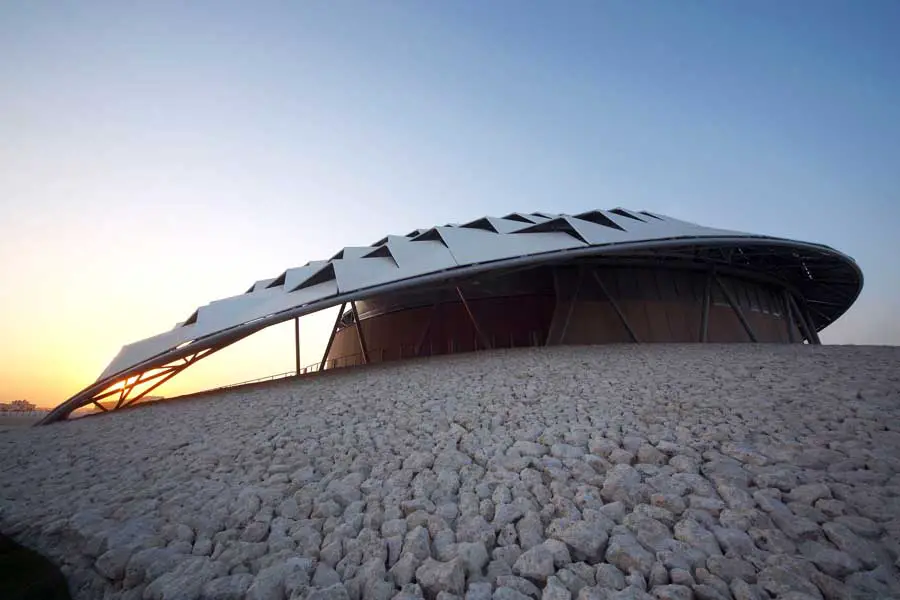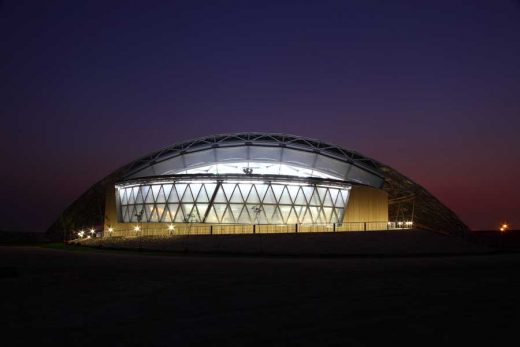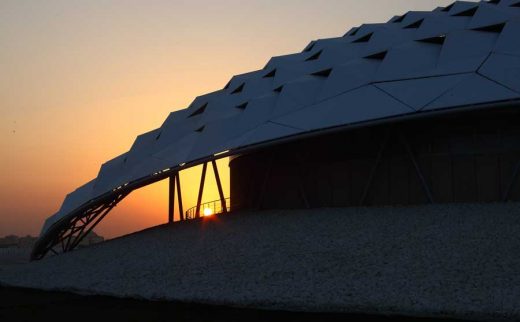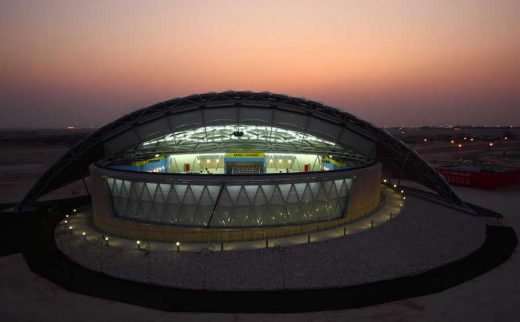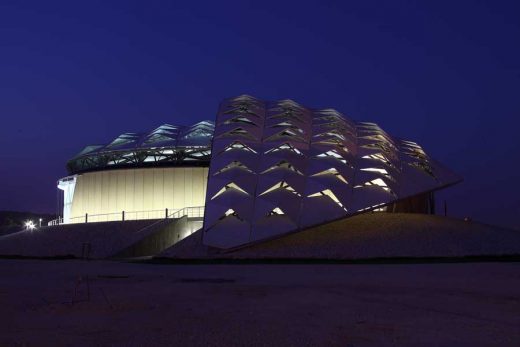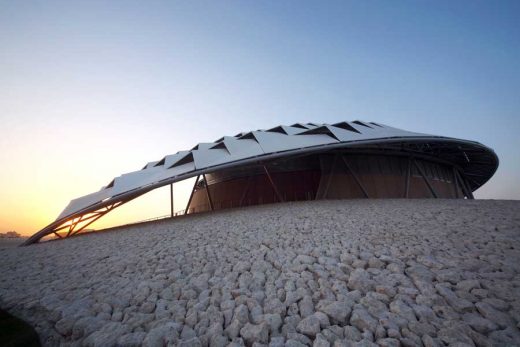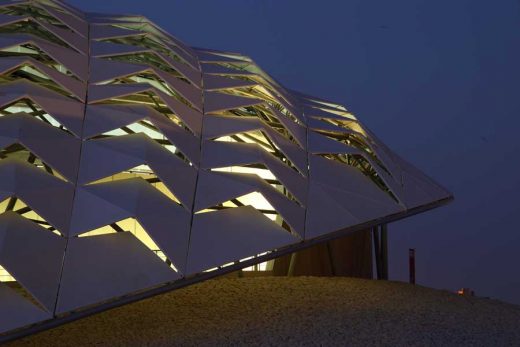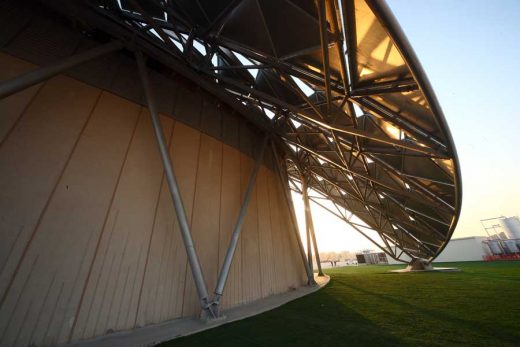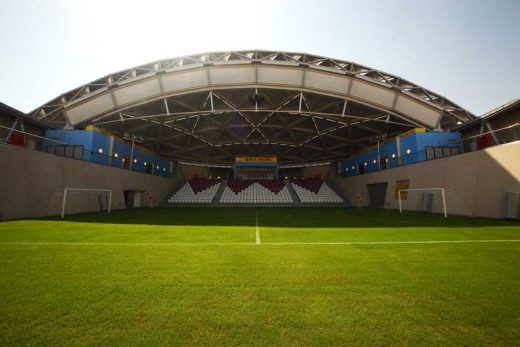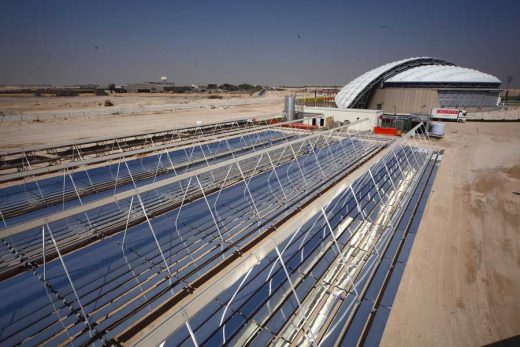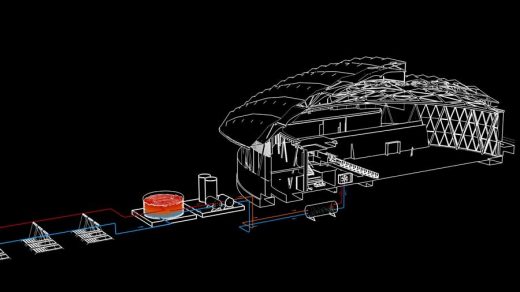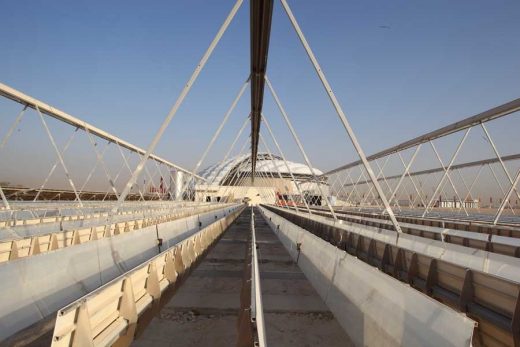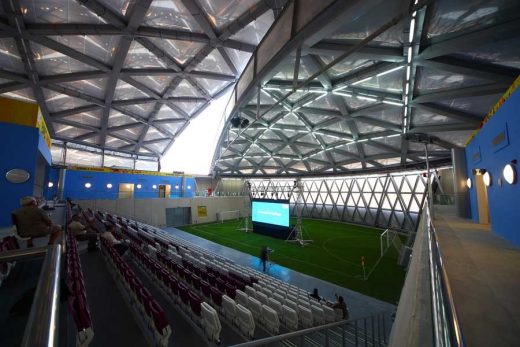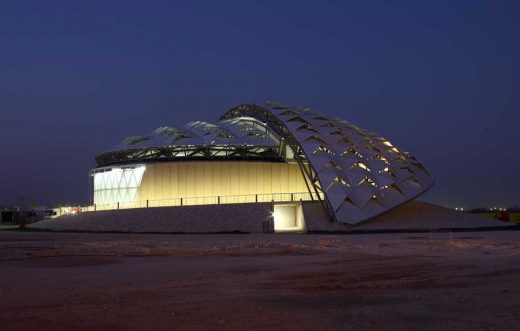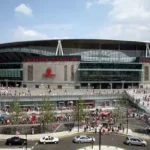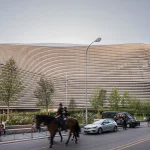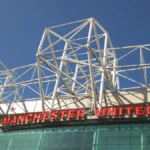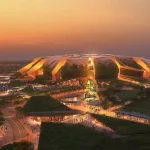Qatar 2022 Showcase Stadium, FIFA World Cup Building, Arena Design Photos
Qatar 2022 Showcase : FIFA World Cup Stadium
World Cup Arenas in The Gulf – Model Sports Development design by Arup Associates
30 Jun 2019 ; 7 Dec 2010
Qatar 2022 FIFA World Cup Stadium
Design: Arup Associates
Qatar World Cup Stadium
Arup Associates’ design for 2022 FIFA World Cup Qatar Showcase is a distinctive building that was a major driver in Qatar’s sustainability plan and FIFA World Cup bid.
As part of the bid, Arup Associates designed a 500-seater “model stadium” that will be carbon zero and be a development platform to refine these technologies for application across Qatar and potentially across all arid regions.
The Showcase was commissioned in order to demonstrate to FIFA and the world-wide audience that the harsh climate over the summer months is no longer a barrier to hosting global events. It is an investigation into innovative, cutting-edge solutions for creating a controlled microclimate over and around the football field, and other public spaces.
Paramount to the Showcase is the promotion of sustainability, environmentally friendly technologies and first-of-its-kind innovation. The Showcase serves as a proof-of-concept for innovative cooling and climate control technologies.
The Showcase is based on three key aspects: an exciting architecture and structure which develops traditional passive design ideas to a new energy-saving and comfortable architecture; photovoltaics that convert the energy of the sun into electricity; capturing and converting the sun’s heat into cooling for summertime airconditioning using under-seat supply.
The ideas used in this Showcase are intended to show how energy can be considered as an integrated aspect of architecture, engineering and infrastructure with renewable energy contributing for the first time at scale in Qatar. Following Qatar’s success in the bid, a range of stadia, fan zones and other facilities will be required for The World Cup Games which will take benefit from these design ideas and technologies.
Michael Beaven, Practice Principal from Arup Associates and Arup’s Sustainability Leader presented the project on site to the FIFA 2022 Inspection Team, alongside His Excellency Sheikh Mohammed bin Hamad bin Khalifa Al Thani, Chairman of the Qatar 2022 Bid Committee. Other bidding countries for the FIFA 2018/2022 were Australia, Japan, Russia, South Korea, UK and USA.
There were also joint bids from: Belgium & The Netherlands as well as Spain & Portugal. The Showcase, Qatar’s “model stadium”, is complete after a construction period of only 4 months, with its key design elements – a revolving canopy roof, summer-time airconditioning and solar energy systems – now operational and supplying zero-carbon energy and cooling from the sun.
More on the groundbreaking Arup Associates Design for Qatar 2022 Showcase
The revolving roof canopy
The compelling rhythmic geometry of The Showcase’s canopy roof plays an important part in the sustainability strategy of the stadium. The canopy roof moves to provide cooling shade within the building and insulated against the hot sun in summer. It is the first roof of its type and is already considered a pioneering move towards a more environmentally responsible approach to stadia architecture.
In addition to protection from sun-light, the canopy can be positioned to protect from wind during match times and let spectators and players take advantage of natural ventilation when the weather is suitable – in Qatar the weather is great for football most of the year.
In hot conditions, the canopy can be closed in the run-up to an event to allow cooling to work at maximum efficiency, using cooling from the sun to cool down the volume ready for match time; in Qatar invariably in the summer evenings, when the roof can be opened to reveal the view of the sky. More below on how the power of the sun is captured to generate power and how solar cooling of the building volume is achieved.
On approaching the Showcase, there is a “solar farm” made up of photovoltaic panels and Fresnel parabolic mirrors which focus the sun’s energy onto pipes that, in this case, have water running in them, capturing the sun’s energy.
Power from the Sun
Just outside the Showcase is a photovoltaic installation- a sun farm, connected to the structure’s electrical system and the national grid. The venues’ solar panels will operate year-round, continuously exporting electrical energy to the national grid.
On a match day, the higher electrical demand will bring electricity back into the facility from the national grid. This national grid electricity, together with generators using biofuels, provide robust and reliable power for both technical and general power, so the events are assured power during the World Cup.
The amount of electricity generated in this way from the sun exceeds the amount of electricity imported for events over the year, making the facility zero carbon for electricity.
Chilling The Showcase
On the site, next to the photovoltaic panels is an array of solar heat collectors. These represent the latest generation of solar heat collectors and have a series of motorised mirrors that track the sun, focussing the sun’s power onto collecting tubes which have hot water circulating in them. They collect this energy in the form of heat, which is converted into cooling for the Showcase environment, and electricity to supply lighting, power and other functions within the space.
The solar energy heats water to 200C and is converted to cooling water by machines called absorption chillers. These have been used for the last 100 years in industrial cooling systems. The cooling is then stored in eutectic tanks beneath the Showcase for use in the evening when it’s circulated into the air-handling units.
The air-handling units supply this air to the area beneath the spectators seats. This cools the seating area and flows down to create cooling for the players. Importantly, the surfaces of the Showcase are designed to remain cool throughout the match to help to stabilise the heat gains from lights and people.
The maximum temperatures are well below the guidelines by the FIFA medical committee to avoid players suffering significant heat stress and also beat the ASHRAE comfort standards for spectators. During the FIFA visit, with an outside temperature having reached 44 degrees only two hours earlier, the temperature on the pitch was recorded as 23 degree C.
Prior to The Games, The Showcase runs empty and without people for the day before the event; thus, making best use of the sun’s free energy to cool the building and the pitch down. The shading roof remains closed over the space until the sun has passed overhead and the roof can be opened without letting the sunshine heat up the space.
Unless the outside conditions are extremely hot and windy, then the roof and walls open to the sky and the match can commence. There is also a wall that can be opened in the Showcase to demonstrate how fan-zones may be considered during the World Cup.
The Qatar 2022 Showcase offers the most sophisticated techniques for capturing and storing the power of the sun. And, as all the energy for the showcase is generated from the sun, over the year, the building has no carbon emissions.
Arup Associates Other Recent Sports Building High-lights Arup Associates has pioneered sustainable development since its inception in 1963. The practice has recently designed two highly acclaimed sports venues. One for The 2002 Commonwealth Games in Manchester, now home to the Manchester City Football Club. It was the first stadium that could be converted for another use and made designers around the world rethink the legacy prospects of spectator sports architecture.
More recently, Arup Associates were awarded Sports Architect of The Year (2008) on the back of their work for the Cricket World Cup Ground in Barbados. This building received much praise for the spectator and community experience of the sport.
Photographs: Gem Advertising & Publications
Qatar 2022 Showcase Stadium images / information from Arup Associates
Location: Doha, Qatar
Qatar World Cup Stadium Buildings
World Cup Stadiums Qatar – FIFA World Cup 2022
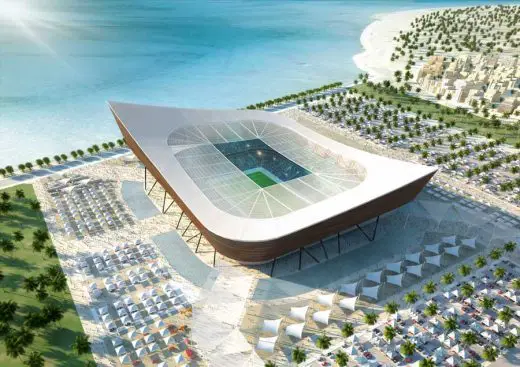
image © hhvision, Cologne
World Cup Stadiums Qatar
FIFA World Cup Stadium Qatar – another key football building design:
Lusail Iconic Stadium
Design: Foster + Partners
![]()
image from architect
Lusail Iconic Stadium Qatar
Qatar Architecture
Contemporary Architecture in Qatar
Qatar Architecture Designs – chronological list
Barwa Financial District Doha
Design: KEO International Consultants
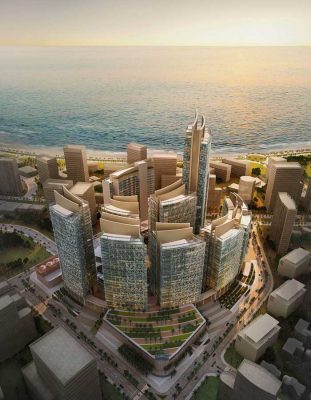
image from architect
Museum of Islamic Art Doha
Design: I M Pei
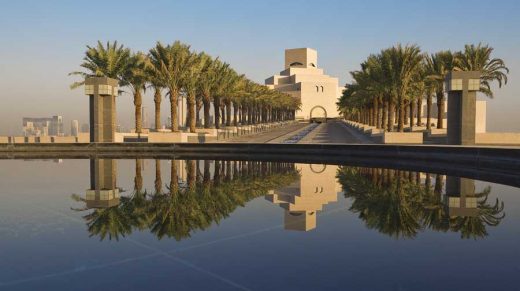
image from architect
Comments / photos for the Qatar 2022 Showcase FIFA World Cup Stadium Doha Architecture page welcome
Website: Visit Qatar

